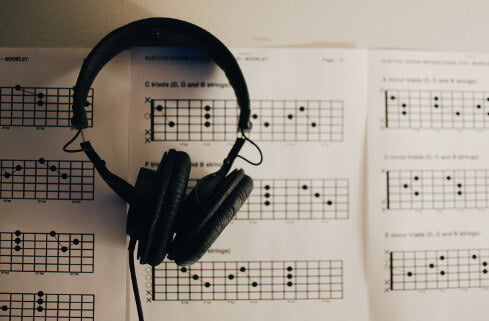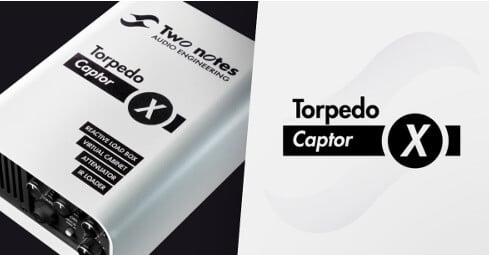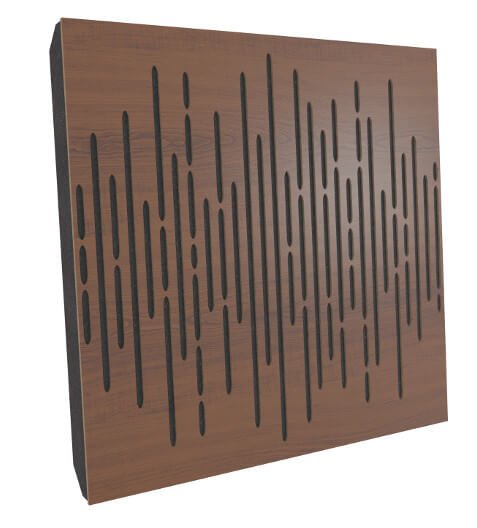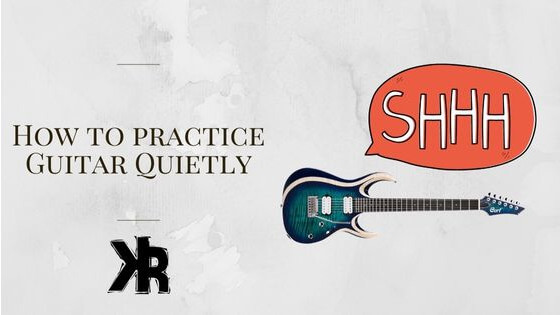Table of Contents
It’s often said that practice makes perfect. And for musicians, there’s no exception. If you want to get better at playing the guitar, you need to do so regularly.
Even when your neighbors are trying to sleep. Fortunately, there are ways to practice guitar quietly. So you don’t disturb anyone else in the process.
When practicing an electric guitar quietly, use headphones. Most amps you can buy come with this feature built-in. If you are playing acoustic, there are ways to muffle the sound to limit the volume.
In this Killer Rig article, we’ll discuss how to practice both electric and acoustic guitars. Both quietly and effectively. So whether you’re a beginner or an experienced player, read on for some useful tips!
How to Practice Electric Guitar Quietly
There are several ways that you can play the electric guitar quietly:
- Play without a device.
- Use a Practice Amplifier.
- Get a Headphone amp.
- Use an amplifier load box.
- Get a Multi-Effects Pedal.
- Use a Laptop.
Play Without an Amp
One of the best ways to practice the electric guitar quietly is to play it on its own. This will help to reduce the amount of sound that is being generated. This will make it easier for you to practice without disturbing others.
You can use this approach when practicing at home or when playing in a small room, even just to warm up before a gig. Another advantage of the guitar this way is that it will help you to focus on your playing.
Do you have your amplifier turned up high? Sometimes it can be easy to get carried away and start getting louder than you intended. So by using it on its own, you are forcing yourself to play with more precision and accuracy. Focusing only on improvement.
The volume will be incredibly low. So low, that your pick striking the strings will be louder than the sound the instrument will produce.
Use a Practice Amplifier
A practice amplifier can also be a great way to reduce the amount of sound that is being emitted from your guitar. This is because they often have a headphone jack. This will allow you to plug in and play without disturbing anyone.
Some practice amplifiers also come loaded with speaker simulations. So you can continue to get a great sound from your amplifier right to the headphones. This means you can run your favorite speaker combinations and no one would hear them but you.
It was once true that if you wanted a great gain sound, it would have to be through the speakers. But today that is no longer the case. By playing with headphones, you can focus on enjoying the guitar. All while keeping a great tone going for inspiration.

Headphone or Mini Amp
A headphone, or mini amp, is a device that plugs into your guitar jack. It provides an output for phones only, as they don’t require much power. Some are very basic with the option for volume. But others provide some decent tone-shaping controls, like:
- Gain
- Tone
- Volume
The Vox headphone amp is probably one of the more popular models available that provide a good sound. There are also others available that provide different sounds from rock to metal. If that is more your tone anyway.
Load Box

When playing at home or in a small room, using a load box can be a great way to keep the sound down.
A load box is a device that is placed between the amplifier and the speaker cabinet. It takes the power from the amplifier and converts it into heat. It then dissipates through the speaker cabinet.
This means that you can play your guitar at high volumes without disturbing anyone. This option is a bit louder depending on the load box you choose. It also depends on how quiet you need to be. But it allows you to play your favorite amplifier at some pretty high levels.
There are a number of different load boxes available on the market, but some of the more popular ones are:
- Fryette Valvulator II
- Palmer PDI-06
- The THD Hot Plate
- Two Notes Torpedo Captor X
Each of these has its benefits, but they all essentially do the same thing. They allow you to play your guitar at high volumes without the sound being too loud.
Some will allow you to use speaker simulations or impulse responses. You can then put that output into your headphones for a realistic sound.
Use a Multi-Effects Pedal
There are also some great multi-effects processors and pedals. They provide a realistic guitar tone through headphones. These units can be great as they normally provide amp sims plus effects. All you need to do is plug in your guitar and headphones and play.
Some popular brands making great processors are:
- Boss
- Line 6
- Fractal Audio
- Kemper
While some of these units are a bit more expensive, they can also be used in a rig no matter what it is you are doing. So not only can they benefit you for quiet practice. They can go into your live rig using connections like the 4 cable method when it needs to be loud!
Use a Laptop
If you have a laptop, there are some excellent plugins available that sound almost amp like. In order to connect your guitar, you will need an audio interface. Something like the Scarlet 212 will work perfectly.
Once it’s connected to your laptop, you can plug your guitar in and jam. Then, use your headphones with your laptop to play silently. This will allow you to get good tone and not bother anyone else around you.
This is also an excellent way to record. Find your favorite recording software and you can capture your songs easily.
How to Practice Acoustic Guitar Quietly
The acoustic guitar is designed to create a full, deep sound and project a decent volume when doing so. But what happens when you want to practice late at night? Or during a time when quiet is appreciated by others close to you?
This can be quite a challenge, especially when you really want to work on learning the guitar! But there are a few ways you can dampen the sound.
- Lighter Strings
- Use your fingers instead of a pick
- Get a Sound Hole Cover
- Use a string damper
- Fill the body
- Palm mute more often
- Adjust room acoustics
- Get a travel guitar
Light Strings Produce Less Volume
Not concerned about getting the biggest sound possible from your acoustic? Then one thing to keep in mind is that lighter strings produce less volume. While this won’t make a very large difference, it does help when you are trying to practice quieter.
Lighter strings have less tension and mass. They will not vibrate nearly as much as thicker ones. In this case, every bit can help and so when you are putting strings on your guitar, consider using a thinner set.
This way, there is a bit less volume to dampen, which can help when done with other techniques.
Use Your Fingers Instead of a Pick
One way to play the acoustic guitar quietly is to use your fingers instead of a pick. Strumming with your fingers is using less surface area to make contact with the strings.
Skin making contact with a string instead of a hard pick will soften the volume produced.
Have you ever noticed that using a pick produces much more volume? More than the dampened tone your fingers make when you strum anyway. This results in a quieter sound.
Use an Acoustic Sound Hole Cover
A sound hole cover is a simple device that can be placed over the hole on an acoustic guitar. This will help to muffle the instrument and limit the volume that is produced. It’s a cheap and easy way to quiet your acoustic playing. All without having to make any major modifications.
There are a few different types of sound hole covers available on the market. You can find simple rubber or foam covers. Or you can purchase a muting system that attaches to the bridge of your guitar.
Whichever type of cover you choose, it’s important to make sure that it fits snugly over the sound hole. If there is any space between the cover and the guitar, the sound will still escape. So you will not be able to muffle it as effectively.
Use a Mute Damper
There is a device made from silicon rubber that goes in between your strings. Great at stopping all vibration. It’s a pad called a mute silencer and is powerful at stopping sound. The only issue is, that it might stop all sound. Because it gets wedged between the strings, it doesn’t allow them to vibrate.
This can be handy if you are only practicing scales or doing finger exercises that don’t require any sound. But if you are expecting it to still project any volume, it might not.
Some players use them and say that it all depends on where it’s positioned. Others don’t like them because there is no sound on their guitars at all.
Perhaps your mileage will vary, but it all comes down to what you want. If you’re just going to be practicing scales and working out your fingers. Then this is the way to go if you need ultra-quiet.
And they are cheap enough that it can’t hurt to have them around. Especially if you ever need a completely muted guitar.
Fill the Acoustic Guitar Body
Playing an acoustic guitar and don’t want to use any of the techniques mentioned above? One way to help reduce the volume is to fill the body with something. This could be anything from T-shirts or rags to Styrofoam or anything like it that can fill the body.
The idea is that by filling up the body of the guitar, you are stopping some sound from escaping. This won’t completely muffle the sound, but it can help to reduce it. You see, the body is a resonant chamber. It’s designed to amplify the strings by the size and depth of the body cavity.
It’s the same concept as a drummer filling the bass drum with things like pillows to dampen the sound. The less room for vibration to grow in intensity, the lower volume that can be produced.
Just make sure that whatever you put into your guitar, can easily be taken out again when you want full volume.
If you decide on small items, they might be very hard to fish out again. So don’t make it more difficult, try using convenient items.
Palm Muting
If you are playing an acoustic guitar and want to practice quietly, palm muting is a great technique to use. It will help to reduce the volume that is being produced and make it easier for you to practice.
All without disturbing others. It also doesn’t require any other items or modifications to use effectively.
To do this, place your strumming hand over the strings using the side of your palm while you are playing them. This will dampen the sound and stop it from projecting as loudly.
You can palm mute for any type of technique. But it’s particularly useful for playing rhythm chords. When using chords, there is usually a lot of strumming involved. By using palm muting, you can significantly reduce the sound that is being emitted.
You can also use palm muting when playing solo acoustic guitar. This will help to muffle the sound and make it more manageable.
Just be aware that if you are playing a song that requires a lot of aggressive strumming. You might not be able to use this technique without adjusting the style.
Adjust Your Room Acoustics

One of the best ways to practice playing the guitar quietly is to prepare your room acoustics. You can do this by using acoustic treatments and heavy curtains. Or filling the room with furniture and stuff. This can help absorb sound, especially if the materials are just right.
By using acoustic treatments, you can help to deaden the sound that is being emitted from your guitar. This will help to reduce the volume that is being heard in the room. There are several acoustic treatments that you can use, such as:
- Foam panels
- bass traps
- broadband absorbers
You can find these products at most music stores or online. If you are handy with carpentry, you could also make your acoustic panels.
Another way to help reduce the sound that is being emitted from your guitar is by using heavy curtains. By hanging heavy curtains around your playing area, you can help to absorb some of the sounds.
This will help to muffle the noise and make it easier for you to practice without disturbing others. If these things are not possible, then try and direct your sound to something that might absorb it. For example, maybe you have a full clothes hamper sitting in your room.
Sit on the floor right in front of it and direct the volume towards it. This way you are low to the ground and have a hamper of clothes that will absorb some sound. Get creative and try a few things out like this.
Use a Quiet Guitar
There are some models on the market that are made for people who travel often. They are small, light, and quiet. There are different types of travel guitars and so getting the right one is important.
Some are designed so as not to have a big body that acts as a resonant chamber, thus producing less sound.
Then there are some that stills have a resonant chamber and are just smaller acoustics. So when selecting a guitar like this, just make sure to pick the one that will provide the amount of volume you need.
Some people might need less volume. But this can be a great way to still make practice possible late at night.
Practice Without a Guitar
We normally equate guitar practice as always having to use an instrument. But other things can be done when it needs to be quiet. Especially if you are teaching yourself how to play.
One is working on theory exercises. This can help you better understand the music you are playing and assist with your technique. To be fluent in reading music and quick to recognize notes is a huge benefit to any musician. If you can’t make noise, then consider some theory to improve your skills.
Another great thing to practice without a guitar is finger workouts. This can help with dexterity and playing techniques. By doing these exercises, you will start to see improvement in your abilities.
Find some strengthening techniques and do them to help finger separation and strength.
Both of these things can be done with just a piece of paper and a pencil. So there is no need to have a guitar to practice with. And they can be very important when you are trying to improve your playing skills.
Conclusion
There are many ways to get into the practice session without making a lot of noise. Most of us have things around the house that can help quiet down our guitars. If one of these methods has caught your interest, then I suggest you look into it more.
The sooner you can figure out the noise issues you have, the better off your progress will be as a guitarist.
FAQs
Can You Use Headphones with an Acoustic Guitar?
Yes, if you own an electro-acoustic model, you can plug your guitar into an amp and use headphones. The trouble with this is that the instrument will still be very loud without any treatments.
We touched on a few ways that an acoustic can be dampened above. If there is no attempt to mute the guitar, then it will still be just as loud. Headphones will only benefit you if you’re looking for tonal changes. Not seeking a quieter practice time.
Are Electric Guitars Silent?
While an electric guitar is very quiet when it’s not being amplified, it is not completely silent. Depending on what you are playing or how hard you are strumming. The electric guitar will still project some sound.
Now it is a fraction of what an acoustic will make, but if you need absolute silence then this could be tricky.
The sound of the pick hitting the strings will also be quite loud. So you might also opt to use your fingers and strum lightly. This will lessen the volume the guitar will make tremendously.
What if My Guitar is Just Still Too Loud?
Unfortunately, there is only so much a player can do to quiet down a guitar. Can’t get it quiet enough to please those around you? Then you may want to practice some theory and learn new methods.
Watch some YouTube videos of players performing things you want to learn. Maybe study theory or take online lessons that don’t involve playing. You can also do finger exercises and spend time improving flexibility.

